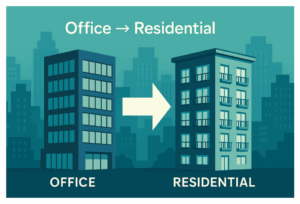Introduction
The New York commercial real estate sector in 2024 presents an intricate picture of opportunities amidst challenges. The market, still reeling from the 2023 downturn exemplified by the Chetrit Group’s significant loss in the sale of 850 Third Avenue, is on the cusp of transformation. This article delves deep into the factors shaping the 2024 landscape, informed by economic theories and market expertise, providing a comprehensive outlook for investors, developers, and stakeholders.
The 2023 Scenario: A Prelude to Change
In 2023, the commercial real estate market in New York experienced a jolt with the Chetrit Group’s 23% loss in the sale of 850 Third Avenue. This incident served as a stark reminder of the market’s unpredictability. The year saw a struggle with declining occupancy rates, an oversupply of commercial spaces, and evolving tenant preferences, setting a complex stage for 2024.
Economic Foundations Influencing the Market
Interest Rates and Their Impact on Real Estate The Federal Reserve’s stance on interest rates in response to inflation significantly influences the real estate market. Higher borrowing costs could dampen investment enthusiasm, potentially affecting property values and investment decisions.
Global and Local Post-Pandemic Recovery The trajectory of recovery from the COVID-19 pandemic will be crucial in shaping demand for commercial spaces. The pace of global and local economic rebound will impact tenant demand, particularly for office spaces.
Technological Advancements and Workplace Evolution The rise of remote work technologies has prompted a reevaluation of the need for physical office spaces, influencing space utilization and design.
Emerging Trends in 2024
Growing Demand for Flexible Workspaces The evolving work culture is fostering a demand for flexible, hybrid-friendly work environments. Properties offering adaptable layouts and shared amenities are expected to gain popularity.
Sustainability: A Key Factor in Real Estate The growing emphasis on sustainability is reshaping the real estate landscape. Eco-friendly buildings and practices are becoming increasingly significant, with such properties likely commanding a premium.
The Rise of the Tenant-Centric Approach To attract and retain businesses, landlords may need to adopt a more tenant-centric model, offering customized leases and amenities.
Navigating Market Challenges
Addressing Over-Supply in Certain Sectors The oversupply of Class A office spaces, especially in areas like Manhattan, poses a challenge, potentially leading to price adjustments.
Adapting to Evolving Tenant Needs The changing nature of work requires landlords to be flexible in responding to tenant needs, especially concerning technological infrastructure and space design.
2024 Market Projections
Consolidation and Market Caution A period of consolidation is expected, with developers and investors adopting a cautious approach. This trend may slow down new developments and emphasize redeveloping existing properties.
Opportunities in Adaptive Reuse The adaptive reuse of office spaces for alternative uses like residential or mixed-use developments may present new opportunities.
Resilience of the New York Real Estate Market Despite challenges, the market is expected to show resilience, supported by New York’s status as a global business hub and ongoing infrastructural developments.
Leveraging Opportunities
Strategic Investments in Emerging Trends Investors and developers can leverage the emerging trends by strategically investing in properties that cater to the evolving market demands, particularly in sustainable and flexible workspaces.
Innovation in Real Estate Technology Embracing technological advancements in real estate, such as smart building technologies, can offer a competitive edge and meet the changing expectations of tenants.
Building a Sustainable and Resilient Portfolio Focusing on sustainability and resilience in property investments can ensure long-term value and appeal in the dynamic real estate market.
Risk Management Strategies
Mitigating Risks in a Volatile Market Employing robust risk management strategies is essential in navigating the volatility of the New York commercial real estate market. This includes thorough market analysis and prudent financial planning.
Diversification and Long-Term Planning Diversifying investments across various sectors and planning for the long term can help mitigate risks and capitalize on market opportunities.
Legal and Regulatory Compliance Adhering to legal and regulatory standards is crucial in ensuring sustainable and compliant real estate practices, especially in a complex market like New York.
The Future Landscape
Future of Work and its Impact on Commercial Real Estate The evolving nature of work, including the rise of remote and hybrid models, will significantly impact commercial real estate, necessitating adaptive strategies from stakeholders.
Predicting Long-Term Market Behavior Long-term market predictions require a deep understanding of economic, social, and technological trends, offering insights into future investment opportunities and risks.
Conclusion
The New York commercial real estate landscape in 2024 is set for a transformative phase. Marked by the lessons of 2023 and driven by flexibility, sustainability, and a tenant-centric approach, the market offers a blend of challenges and opportunities. Stakeholders need to leverage economic insights and strategic foresight to navigate this evolving terrain.




